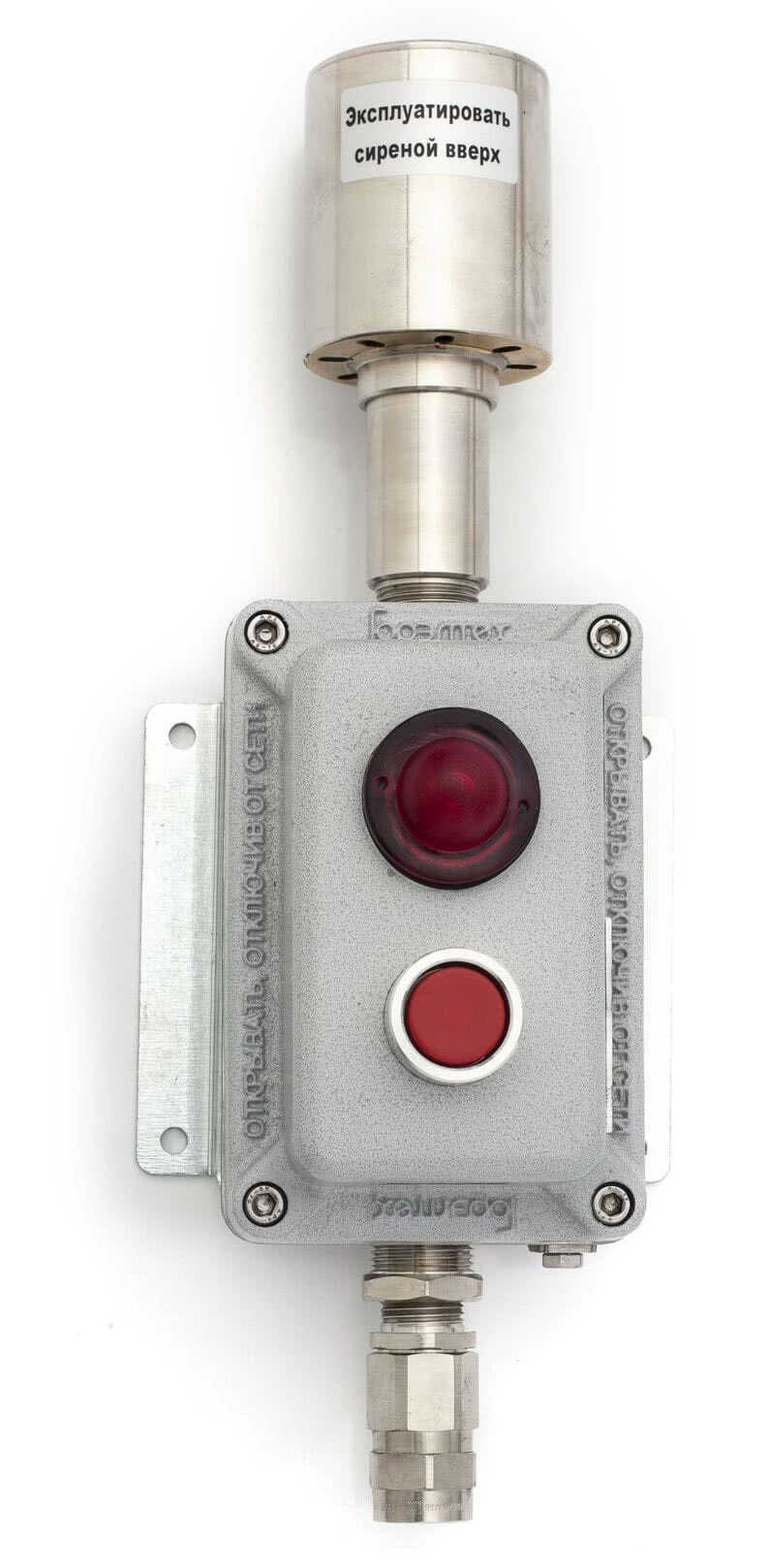

 PURPOSE AND SCOPE OF APPLICATION
PURPOSE AND SCOPE OF APPLICATION
Explosion-proof light and sound signaling device PGSK02 is a special-purpose signaling device intended for application in hazardous areas in security and fire alarm systems and other signaling systems. Explosion-proof light and sound signaling device PGSK02 is intended for continuous round-the-clock operation in a stand-by mode (possibility to send sound alarm signals) in hazardous areas of industrial and construction facilities where flammable gases and dust are present. Maximum level of sound pressure is 106 Db, 102 Db (for mining version). The signaling device is supplied with different cable glands.
Application of PGSK02 explosion-proof sound signaling devices with a high level of output signal in large and/or noisy areas guarantees effective signalization with a powerful and precise level of signal. Application of signaling devices with high level of sound pressure is economically reasonable since the number of signaling devices is reducing, hence number of cables and terms of installation.
Full production cycle from foundry patterns to finished products is carried out by explosion-proof equipment plant “ZAVOD GORELTEX” Co. Ltd. in the territory of the Russian Federation.
Scope of application – outdoor and indoor hazardous areas and pits non-hazardous with gas or dust, as per explosion protection marking, GOST 30852.13-2002 (IEC 60079-14:1996), regulating application of electrical equipment in hazardous and non-hazardous areas at dangerous production facilities of I, II, III, IV hazard class supervised by Rostechnadzor and national technical supervision bodies of the CIS countries.
 1Ex db e mb IIC T6 Gb
1Ex db e mb IIC T6 Gb 1Ex db [ib] IIC T6 Gb
1Ex db [ib] IIC T6 Gb Ex tb IIIC T80°С Db
Ex tb IIIC T80°С Db ЕАЭС RU C-RU.НА67.В.00159/20
ЕАЭС RU C-RU.НА67.В.00159/20 ЕАЭС RU С-RU.МЛ02.В.00061/19
ЕАЭС RU С-RU.МЛ02.В.00061/19 ЕАЭС RU С-RU.АБ53.В.00229/20
ЕАЭС RU С-RU.АБ53.В.00229/20 ЕАЭС RU C-RU.ПБ74.В.00150/20
ЕАЭС RU C-RU.ПБ74.В.00150/20 ГОСТ Р ИСО 9001-2015 (ISO 9001:2015)
ГОСТ Р ИСО 9001-2015 (ISO 9001:2015) RU.OC ВССТ 0180-12-2023
RU.OC ВССТ 0180-12-2023 ТУ 3400-005-72453807-07
ТУ 3400-005-72453807-07 ТУ 27.90.20-038-72453807-2017
ТУ 27.90.20-038-72453807-2017 IECEx CCVE 19.0005X
IECEx CCVE 19.0005X EESF 19 ATEX 035X
EESF 19 ATEX 035X KZ39VEH00005608
KZ39VEH00005608 РОСС RU С-RU.МЮ62.В.00095/23
РОСС RU С-RU.МЮ62.В.00095/23 1Ex db [ib] IIC T6 Gb)
1Ex db [ib] IIC T6 Gb) 12/24 или ~220
12/24 или ~220
| PGSK02 | - | Х | - | Х | Х | - | Х | Х | - | Х | / | Х | – TU 3400-005-72453807-07 |
| Name of device | |||||||||||||
Supply voltage:  12/24 V - 12DC; ~220 V - 220AC 12/24 V - 12DC; ~220 V - 220AC |
|||||||||||||
| Type of control/indicating element: Lamp - L; Button - К | |||||||||||||
| Color of control/indicating element: Red - К; Yellow - ZH; Green - Z; Black (for button) - CH |
|||||||||||||
| Dimension type of cable gland | |||||||||||||
| Options, accessories and versions |
Example: PGSK02-12DC-LZH-LK-KNV1N-TU 3400-005-72453807-07
Recommendations on choice of color of beacons light signals according to IEC 73 standard:
Red signal (K) – Danger. Respond immediately. Danger for life or movement of the equipment in secure zone without protection.
Amber yellow signal (ZH) – Warning! Act cautiously. Temperature or pressure deviates from the norm.
Green signal (Z) – Precautionary measure. Act. The test is completed, machine is ready for start.
Blue signal (S) – Installed at place. Settings are ready or remote control.
White signal (B) — Has no special meaning. Can be a confirmation of an earlier signal.
According to GOST R IEC 60073-2000, sound signals may be applied in cases when:
– it is required to draw an operator‘s attention;
– coded information will be short, simple and transient;
– the information requires immediate time-dependent answer;
– application of visual signal is limited;
– the situation is critical and it requires additional or redundant information.
The sound signal may consist of pure or complex tones (not more than 5 signals). The sound signal must be audible and easily recognized by operators and people in the set area of signal reception and at set background noise conditions. Signals must be different from the emergency signal, as per ISO 8201 part 7.
Sound signals of different types must be clearly distinguishable from each other.
Limited audibility of signals must be also taken into account in cases, when employees wear protective devices or earphones, as well as people with hearing impairment.
General rules of identification of sound signals when coding the information:
To prevent sound overpressure of operators, it is required to use minimum amount of sounds of different kind in this application.
Intermittent sound signal may be used in some particular cases (for example, in case of change of dangerous or transient state to a safe state). Sound signals should not be applied in case of safe state (silence).